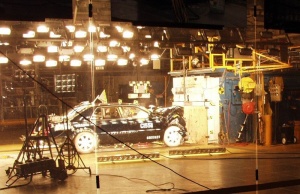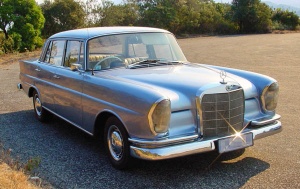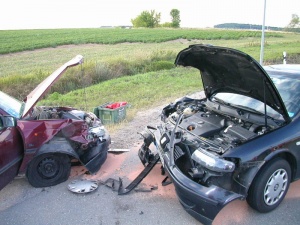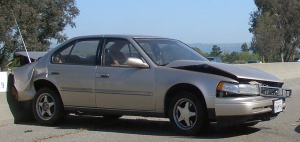Crumple zone

The crumple zone of a vehicle such as an automobile is a structural feature designed to compress during an accident to absorb energy from an impact. Typically, crumple zones are located in the front part of the vehicle, in order to absorb the impact of a head-on collision, though they may be found on other parts of the vehicle as well.
An early example of the crumple zone concept was used by the Mercedes-Benz engineer Béla Barényi on the 1959 Mercedes-Benz "Fintail".
Function
Crumple zones work by managing the crash energy so that it is absorbed within the frontal section of the vehicle (energy is transformed by the deformation instead of being directly transmitted through the body of the occupants), while also preventing intrusion into or deformation of the passenger cabin. This acts to ensure that car occupants are better protected against injury. In simplistic terms, this is achieved by controlled weakening of outer parts of the car while strengthening the inner (passenger cabin) part of the body by using more reinforcing beams and increasingly, higher strength steels.
In an abstract physical sense, a secondary point of crumple zones is to slow down the collision, not just to absorb energy. The difference between slamming someone into a wall headfirst (breaking their skull) and shoulder-first (bruising their flesh slightly) is that the arm, being softer, has tens of times longer to slow its speed, yielding a little at a time, than the hard skull, which isn't in contact with the wall until it has to deal with extremely high pressures. This effect helps to ensure that restraints hold and don't bruise (keeping the pressure at low levels), or that there is less speed differential between the passenger's body and their vehicle (so one doesn't fly through the windshield). In short: A passenger whose body indrectly impacts the soft crumple of metal foil that a crash turns a crumple zone into over a few seconds, survives much more often than a passenger whose body indirectly impacts a hard, undamaged metal carbody which has come to a halt nearly instantaneously.
A common misconception about crumple zones is that they reduce safety by allowing the vehicle's body to collapse, crushing the occupants. In fact, crumple zones are located in front and behind of the main body of the car, compacting within the space of the engine compartment or boot. The marked improvement over the past two decades in high speed crash test results and real-life accidents also belies any such fears. Modern vehicles using what are commonly termed 'crumple zones' provide, on average, far superior protection for their occupants in severe tests than older models.
The only other general downside to crumple zones is that repair costs are higher in "fender bender" accidents.
The 2004 Pininfarina Nido Experimental Safety Vehicle locates crumple zones inside the Survival Cell. Those interior crumple zones decelerate a sled-mounted survival cell.
See also
External links


